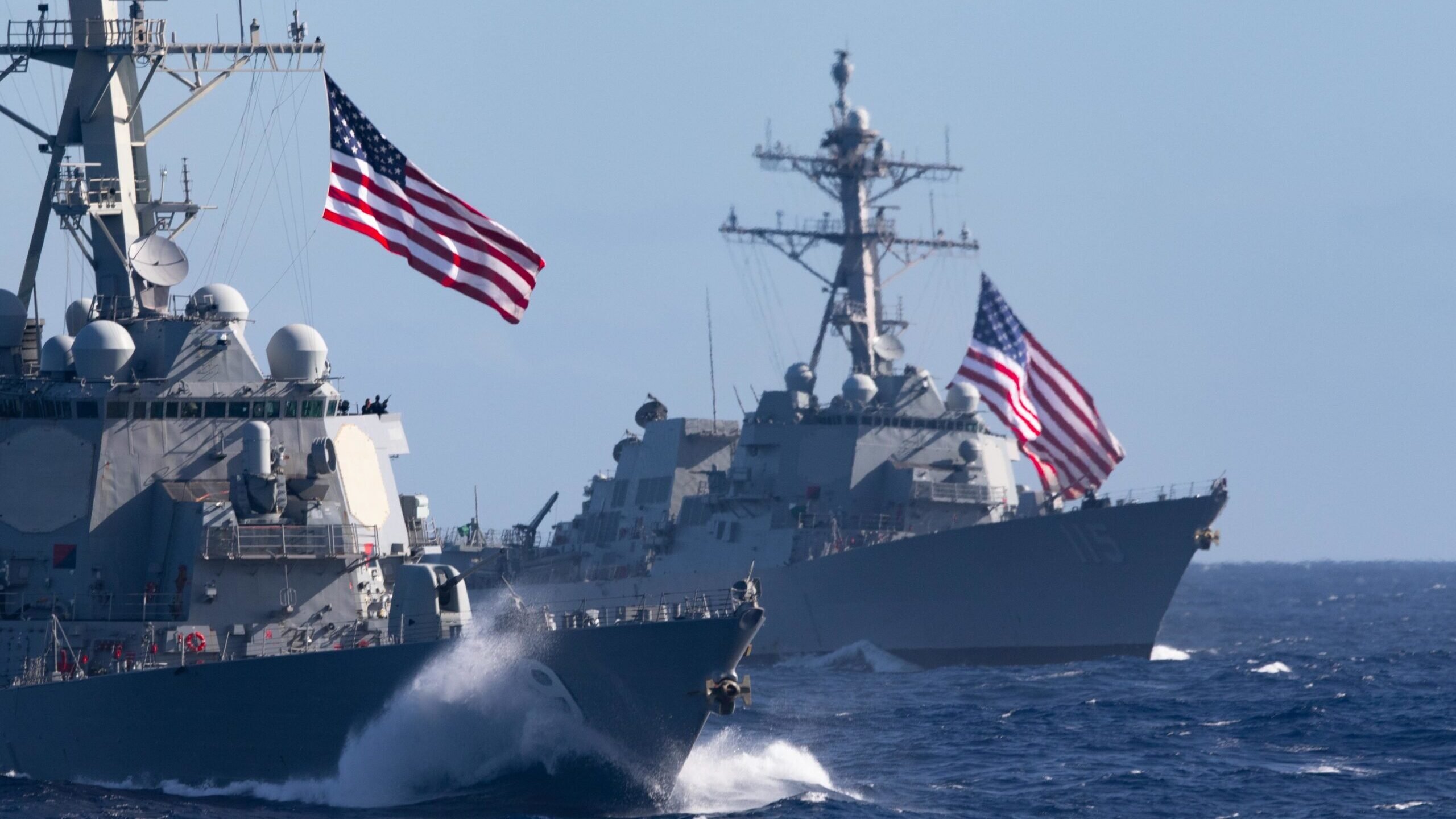
The Arleigh Burke-class guided-missile destroyers USS Russell (DDG 59), left, and USS Rafael Peralta (DDG 115) transit the Pacific Ocean Jan. 25, 2020. (U.S. Navy photo by Mass Communication Specialist 3rd Class Erick A. Parsons)
Updated 8/2/2023 at 4:53 pm ET with comments from Navy officials.
WASHINGTON — The Navy today awarded HII and General Dynamics Bath Iron Works separate multiyear procurement contracts to build nine Arleigh Burke-class destroyers between them, according to the Pentagon’s daily announcements, though the service withheld the contracts’ pricetags.
HII’s contract includes options for six ships, while Bath will build at least three others. The Pentagon’s statement does not disclose the value of either company’s contract because the Navy says it is reserving the right to hold a competition between the two firms for any additional vessels and, therefore, the contract values are “considered source selection sensitive information.” The multiyear procurement contracts will run from fiscal 2023 through 2027, the service added.
“Arleigh Burke class destroyers are the backbone of the surface fleet and one of the most successful shipbuilding programs in the history of the Navy,” Secretary Carlos Del Toro said in a written statement. “These awards provide a long term stable demand signal to the shipbuilder and industrial supply base, encouraging industry investment in the workforce. With our industry partners, we are going to continue to build them; and they will continue to secure the seas for decades to come!”
In the same statement Jay Stefany, the Navy’s acting acquisition executive, added that the Navy saved $830 million by purchasing the ships upfront through a multi-year contract deal rather than negotiating individual deals for each vessel.
The Navy’s previous DDG-51 multi-year procurement contracts with HII and Bath Iron Works for 10 base ships split between them totaled roughly $10 billion, excluding additional money spent on optional vessels.
Rear Adm. Thomas Anderson, program executive officer for ships, told reporters at the Pentagon on Wednesday the service does not currently plan to release the dollar values associated with the new contracts.
“As we mentioned, we reserve our right to compete those options throughout the duration of the multi-year, so there really is on our part no intent to release those numbers,” he said. Pressed by reporters, Stefany added the Navy has previously withheld certain dollar values for multi-year contracts when the service expects to compete options.
Separately, the Navy officials said that the two contracts collectively contain enough options for the service to build up to 15 destroyers over the five year period if provided enough funding — a key priority for lawmakers.
If and when those additional options are executed, Stefany said the service will provide both companies a chance to update their proposals with a lower cost or re-submit their original bids with the same pricing.
The Arleigh Burke-class destroyers are the workhorses of the Navy’s current surface fleet, with the latest iterations, Flight IIA and Flight III, having been kitted out with the best technologies industry can offer to the service. HII and General Dynamics Bath Iron Works are the Navy’s long-standing, go-to shipbuilders for destroyers and have collectively built the entire fleet made up of dozens of vessels starting with Arleigh Burke (DDG-51), named after the eponymous four-star admiral, initially built by Bath and launched in the late 1980s. By contrast, the most recent destroyer delivered by HII, the Jack H. Lucas, bears the hull number 125.
RELATED: HII Delivers First Flight III DDG, Jack H. Lucas, to Navy
“It is a privilege for our shipbuilders to build these ships in service of our Navy,” Ingalls Shipbuilding President Kari Wilkinson said in a statement to Breaking Defense after the contract announcement was published. “We look forward to the years of stability that this award provides and the opportunity to continue working with our industry partners on this important class of ships.”
Chuck Krugh, president of Bath Iron Works, said, “We appreciate the opportunity to build on our history of providing these highly advanced ships for the U.S. Navy fleet and are honored to do our part to contribute to protecting the nation and our families. Flight III destroyers have significantly increased capability and our skilled shipbuilders are committed to producing ships that meet the quality standards that our Navy sailors deserve.”
The most recent DDG-51 multi-year contracts were awarded in September 2018 and ran from fiscal 2019 through 2022, according to Pentagon contract announcements at the time. A Navy spokeswoman did not respond to a question by press time from Breaking Defense about which options have been exercised under the previous contracts. However, the service’s latest budget justification documents indicate that at least 12 DDG-51s were purchased between September 2018 and June 2020.
While lawmakers are usually upbeat about military contract announcements that boost jobs back home, the service is sure to attract pressure from Capitol Hill about how many destroyers it ultimately chooses to build. Lawmakers have opened the pathways legally for the Navy to purchase up to 15 ships in this multi-year procurement contract. However, both Navy leadership and officials from the office of the secretary of defense have expressed skepticism that industry can cope with the workload necessary to produce them at a target rate of three ships per year.
“We’ve seen challenges with the industrial base, producing submarines on time, on schedule, and within within budget. Same thing with aircraft carriers. Destroyers are coming around, but we still have some work to do,” Chief of Naval Operations Adm. Michael Gilday told a Washington think tank in September 2022. “The defense industrial base right now is strained. And a lot of that has to do with the workforce, as we recover from COVID.”
Shipbuilder Austal USA names Michelle Kruger as new president
Kruger had been serving as interim president since former chief Rusty Murdaugh resigned last spring.



























